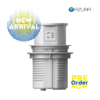A lot of the futuristic technology we see in sci-fi movies is so amazing it’s hard to imagine that it may someday exist in our homes. In reality, it may exist already. Modern technology has advanced to the point where we can now control our TVs, lights and even our thermostats from our smartphone. That’s just the tip of the iceberg.
Here are seven future home technologies that everyone should know about.
- Automated Robots

We are still a long way from a full-featured, humanoid-like robot that can operate freely. That said, automated robots already exist and are being used in a lot of homes today. Devices like the iRobot and Neato are designed to autonomously travel around your home and clean the floors. That’s about as far as we’ve come for consumer-based robots anyway.
Don’t fret, however. A prototype robot unveiled by scientists in Germany does quite a bit more than clean the floors. The one-armed and three-fingered device can pick-up items, tidy up, operate various machines and even serve drinks to guests. An integrated sensor system prevents the robot from clamping down around a human’s arm. Additionally, it can be controlled via an embedded touchscreen, though it also answers to voice commands. It will even respond to preprogrammed gestures.
Of course, this is just one robot that is currently in production. It won’t be long before we see more automated helpers moving into our homes.
- Smart Appliances

As our devices such as our phones, watches and even jewelry become smarter and smarter, we’ll all begin to realize the benefits of owning smart appliances. Imagine a refrigerator that can have a nice glass of water waiting for you when you get to the kitchen — ordered directly from your mobile phone. Think of how awesome an internet-ready microwave would be — automatically tweeting out your quick meal to the world. Okay, so that last example was more of a joke but you get the point.
You can already purchase refrigerators, washers, dryers and other devices equipped with touchscreen displays and a bevy of sensors. A few of them are even internet ready, allowing you to install and use apps directly from the appliance.
What’s most exciting about the idea of smart appliances is that they will become increasingly more convenient, learning your preferences and making lives easier. Although, it does bring up a few questions about what big data companies might track, such as what time you eat every day and information like that.
- Lighting Controls

Turning on a lamp or ceiling light from a wall switch is old fashioned now. Provided you have the right setup in your home, lights can now be controlled from mobile devices, touchscreen panels or an automated system.
NEST, a smart thermostat, can even be programmed to turn on lights in your home and cool the air inside as soon as you return from vacation. Imagine being able to program your system so that it turns on lights at various times of the day or night.
Advanced lighting controls are becoming more commonplace, though many hope that the technology will soon be a standard feature in new homes.
- Power Tracking or Energy Efficient Tech
Your car tells you when it needs an oil change, so why doesn’t your home tell you information like that? Think of an air conditioning unit that can send you alerts when the air filter needs to be changed.
Better yet, think of an energy system that can tell you when you’re going over your power budget for the month. Powerhouse Dynamics, a Maine-based company, has unveiled their Total Home Energy Management program, which does just that. It tracks a home’s energy consumption, associated costs and carbon footprint by the minute, in order to allow homeowners to better manage their usage. It can even analyze appliances and equipment being used in the home and tell owners when they need to upgrade to more energy-efficient products. Furthermore, it’s constantly being modified to add new functionality and become a more useful system.
It won’t be long before there are more than just a couple competitors in the market and power tracking systems become a modern home standard.
- Smart Toilets
It seems a little silly taking a pot that you do your business in and making it “smarter,” but it’s already happening. There are toilets in Japan that will perform a urinalysis after people do their business, and then inform them whether or not they have diabetes — or are at risk for it. It seems that’s one of the main uses for smarter toilets, keeping us healthy, which makes a lot of sense when you think about it. You can learn a lot by analyzing stools and urine. Toilets may soon be able to tell women they are pregnant by analyzing urine, or that someone has colon cancer thanks to their stool.
Of course, other smart features like automated deodorizers and flushing systems, or heated seats are also pretty useful. Especially that last one, because no one likes to sit down on a freezing cold toilet seat.
It’s pushing the envelope a bit, but Kohler’s Numi toilet seat is one of the most advanced and “smart” toilets on the market. It includes an integrated foot warmer, heated seat, deodorizer, air dryer, bidet, motion-activated cover and seat, and of course an illuminated touchscreen panel with support for MP3 music playback. Yep, you can listen to music while you’re taking a … well, while you do your thing.
- Centralized Entertainment and Streaming Devices
Cable TV is overpriced, outdated and pretty inconvenient these days. Sluggish and buggy set-top boxes are only a small portion of the problem. It’s no surprise then that a streaming revolution is happening right now. The future of entertainment lies in a centralized streaming system which provides homeowners — and guests — instant access to their digital entertainment. Thanks to internet-based subscription services like Netflix, Hulu and even YouTube, homeowners can stream content live to their TV relatively cheaply. Of course, it does rely on a decent internet connection, which is a different issue entirely.
That said, future homes will include a more centralized entertainment and streaming system designed to offer convenience and pleasure. For example, it’s about time we did away with cable outlets and moved to installing a closed ethernet network in new homes — it will happen soon, just wait.
Additionally, tablet and mobile smartphone based remotes will become much more common as new technology emerges.
- Closed and Private Networks
Just take a moment to consider how many of your devices are designed to be used with an active internet connection. Along with all the things mentioned in this list, that range of products will expand to include home appliances, tools, monitoring systems and much more.
Future homes will include closed and private network access to connect all of those devices and allow communication between them. Sure, you may have to go purchase a router to get your devices up and running today but hopefully that won’t be necessary someday. Wireless devices will automatically be installed in newer homes, opening them up to a closed network.
This ties in directly with a personal home security system, which can be used with the private network. Facial recognition software would allow homeowners keyless entry into the home or network. A CCTV monitoring system would allow them to patch in remotely and check their home’s status while away on vacation. You could activate an emergency alert mode via a mobile device if something goes awry. The possibilities are endless.








